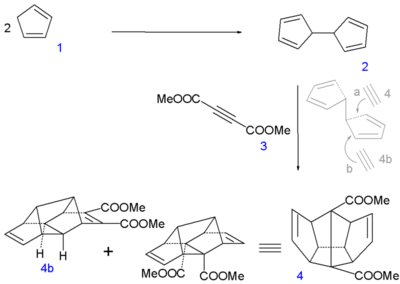- Cyclopentadiene
-
Cyclopentadiene 

 Systematic nameOther names
Systematic nameOther namesIdentifiers Abbreviations CPD, HCp CAS number 542-92-7 
PubChem 7612 ChemSpider 7330 
UNII 5DFH9434HF 
EC number 208-835-4 MeSH 1,3-cyclopentadiene ChEBI CHEBI:30664 
RTECS number GY1000000 Beilstein Reference 471171 Gmelin Reference 1311 Jmol-3D images Image 1 - C1C=CC=C1
Properties Molecular formula C5H6 Molar mass 66.1 g mol−1 Exact mass 66.046950192 g mol-1 Appearance Colourless liquid Density 786 mg cm-3 Melting point -90 °C, 183 K, -130 °F
Boiling point 39-43 °C, 312-316 K, 102-109 °F
Acidity (pKa) 16 Basicity (pKb) -2 Structure Molecular shape Planar[2] Thermochemistry Standard molar
entropy So298182.7 J K-1 mol-1 Specific heat capacity, C 115.3 J K-1 mol-1 Hazards Flash point 25 °C Related compounds Related hydrocarbons Benzene
Cyclobutadiene
CyclopenteneRelated compounds Dicyclopentadiene  (verify) (what is:
(verify) (what is:  /
/ ?)
?)
Except where noted otherwise, data are given for materials in their standard state (at 25 °C, 100 kPa)Infobox references Cyclopentadiene is an organic compound with the formula C5H6. This colorless liquid has a strong and unpleasant odor. At room temperature, this cyclic diene dimerizes over the course of hours to give dicyclopentadiene via a Diels–Alder reaction. This dimer can be restored by heating to give the monomer.
The compound is mainly used for the production of cyclopentene and its derivatives. It is popularly used as a precursor to the cyclopentadienyl ligand ('Cp') in cyclopentadienyl complexes in organometallic chemistry.[3]
Contents
Production and reactions
Cyclopentadiene production is usually not distinguished from dicyclopentadiene since they are interconverted. They are obtained from coal tar (about 10 – 20 g/ton) and steam cracking from naphtha (about 14 kg/ton).[4] To obtain cyclopentadiene monomer, commercial dicyclopentadiene is "cracked" by heating to ~ 180 °C. The monomer is collected by distillation, and used soon thereafter.[5]
Sigmatropic rearrangement
The hydrogen atoms in cyclopentadiene undergo rapid [1,5]-sigmatropic shifts as indicated by 1H NMR spectra recorded at various temperatures.[6]
Diels–Alder reactions
Famously, cyclopentadiene dimerizes via a reversible Diels–Alder reaction. The conversion occurs in hours at room temperature, but the monomer can be stored for days at −20 °C.[4]
Effect of temperature on rate of dimerization of C5H6 Relative rate Temperature (°C) 0.05 _20 0.5 0 3.5 25 15 40 Cyclopentadiene readily undergoes other Diels–Alder reactions with dienophiles such as 1,4-benzoquinone.[7] Cycloaddition of O2 gives the bicyclic peroxide.
Deprotonation
The compound is unusually acidic (pKa 16) for a hydrocarbon, a fact explained by the high stability of the aromatic cyclopentadienyl anion, C5H5−. Simple compounds of this anion (such as the commercially available sodium cyclopentadienide) are often depicted as salts, although the free anion is not present in appreciable quantities in solution.[citation needed] Deprotonation can be achieved with a variety of bases, typically sodium hydride or even sodium metal. The anion serves as a nucleophile in organic synthesis, the preparation of modified cyclopentadienyl ligands, and metallocenes, described in the next section.
Metallocene derivatives
Metallocenes and related cyclopentadienyl derivatives have been heavily investigated and represent a cornerstone of organometallic chemistry owing to their high stability. Indeed, the first metallocene characterised, ferrocene, was prepared the way many other metallocenes are prepared: by combining alkali metal derivatives of the form MC5H5 with dihalides of the transition metals:[9] As typical example, nickelocene forms upon treating nickel(II) chloride with sodium cyclopentadiene in THF.[10]
- NiCl2 + 2 NaC5H5 → Ni(C5H5)2 + 2 NaCl
Organometallic complexes that include both the cyclopentadienyl anion and cyclopentadiene itself are known, one example of which is the rhodocene derivative produced from the rhodocene monomer in protic solvents.[11]
Uses
Cyclopentadiene is mainly useful as a precursor to cyclopentene and related monomers such as ethylidenenorbornene. Such species are used in the production of specialty polymers. Cyclopentadienyl complexes serve as reagents in organic synthesis. It was also used as the starting material in Leo Paquette's 1982 dodecahedrane synthesis.[12] The first step involved reductive dimerization of the molecule to give dihydrofulvalene, not simple addition to give dicyclopentadiene.
Abbreviation
The commonly used abbreviation of the cyclopentadienyl anion is Cp. The abbreviation played a part in the naming of copernicium: the original proposal for the element's symbol was also Cp, but because of the abbreviation for this anion and the fact that lutetium was originally named cassiopeium and had Cp for the symbol as well, the symbol for copernicium was changed to Cn.[13]
See also
- Aromaticity
- Methylcyclopentadiene and pentamethylcyclopentadiene, also found as ligands in organometallic chemistry
References
- ^ "1,3-cyclopentadiene - Compound Summary". PubChem Compound. USA: National Center for Biotechnology Information. 16 September 2004. http://pubchem.ncbi.nlm.nih.gov/summary/summary.cgi?cid=7612. Retrieved 8 October 2011.
- ^ Valery I. Faustov, Mikhail P. Egorov, Oleg M. Nefedov and Yuri N. Molin (2000). "Ab initio G2 and DFT calculations on electron affinity of cyclopentadiene, silole, germole and their 2,3,4,5-tetraphenyl substituted analogs : structure, stability and EPR parameters of the radical anions". Phys. Chem. Chem. Phys. 2 (19): 4293–4297. doi:10.1039/b005247g.
- ^ Hartwig, J. F. Organotransition Metal Chemistry, from Bonding to Catalysis; University Science Books: New York, 2010. ISBN 189138953X.
- ^ a b Dieter Hönicke, Ringo Födisch, Peter Claus, Michael Olson “Cyclopentadiene and Cyclopentene” in Ullmann's Encyclopedia of Industrial Chemistry 2002, Wiley-VCH, Weinheim. doi:10.1002/14356007.a08_227
- ^ Robert Bruce Moffett (1962), "Cyclopentadiene and 3-Chlorocyclopentene", Org. Synth., http://www.orgsyn.org/orgsyn/orgsyn/prepContent.asp?prep=cv4p0238; Coll. Vol. 4: 238
- ^ Streitwieser, A.; Heathcock, C. H.; Kosower, E. M. (1998). Introduction to Organic Chemistry (4th Edn.) Upper Saddle River, NJ: Prentice Hall.
- ^ Masaji Oda, Takeshi Kawase, Tomoaki Okada, and Tetsuya Enomoto (1998), "2-Cyclohexene-1,4-dione", Org. Synth., http://www.orgsyn.org/orgsyn/orgsyn/prepContent.asp?prep=cv9p0186; Coll. Vol. 9: 186
- ^ Fischer, E. O.; Wawersik, H. (1966). "Uber Aromatenkomplexe von Metallen: LXXXVIII. Uber Monomeres und Dimeres Dicyclopentadienylrhodium und Dicyclopentadienyliridium und Uber Ein Neues Verfahren Zur Darstellung Ungeladener Metall-Aromaten-Komplexe" (in German). J. Organomet. Chem. 5 (6): 559–567. doi:10.1016/S0022-328X(00)85160-8.
- ^ Girolami, G. S.; Rauchfuss, T. B.; Angelici, R. J. (1999). Synthesis and Technique in Inorganic Chemistry. Mill Valley, CA: University Science Books. ISBN 0935702482.
- ^ Jolly, W. L. (1970). The Synthesis and Characterization of Inorganic Compounds. Englewood Cliffs, NJ: Prentice-Hall. ISBN 0138799326.
- ^ Kolle, U.; Grub, J. (1985). "Permethylmetallocene 5 Reactions of Decamethylruthenium Cations". J. Organomet. Chem. 289 (1): 133–139. doi:10.1016/0022-328X(85)88034-7.
- ^ Paquette, L. A.; Wyvratt, M. J. (1974). "Domino Diels–Alder reactions. I. Applications to the rapid construction of polyfused cyclopentanoid systems". J. Am. Chem. Soc. 96 (14): 4671–4673. doi:10.1021/ja00821a052.
- ^ "Copernicium Video – The Periodic Table of Videos – University of Nottingham". http://www.periodicvideos.com/videos/112.htm. Retrieved 2011-02-22.
External links
Alkenes Dienes Cyclobutadiene · Cyclopentadiene · Cyclohexadiene (1,3-Cyclohexadiene · 1,4-Cyclohexadiene) · Cycloheptadiene · Cyclooctadiene (1,5-Cyclooctadiene)Categories:- Cycloalkenes
- Dienes
Wikimedia Foundation. 2010.


